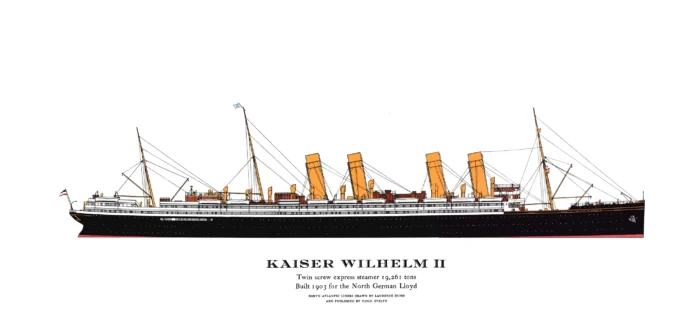S.S. Kaiser Wilhelm II, 1903
Original price was: £25.00.£17.50Current price is: £17.50.
Kaiser Wilhelm II: Norddeutscher Lloyd;
Detail below
Shipping cost is the SAME for 1 to 10 prints – see Shipping and Returns
In stock
- Satisfaction Guaranteed
- No Hassle Refunds (see Shipping and returns)
- Secure Payments
Description
Kaiser Wilhelm II: (From 1919 USS Agamemnon);
Owner: 1) Norddeutscher Lloyd; 2) the US War Department on seizure in 1917;
In service: 1903-1940;
Route: Germany to New York; US Army transport after 1917;
Built: A-G Vulcan, Stettin, Germany;
Launched: 1902; Maiden Voyage: 1903;
19,361 GRT; L: 706 ft (215 m); B: 72 ft (22 m);
2 x screws; 23.5 knots (43.5 km/h; 27.0 mph);
Passengers: 1st 775; 2nd 343; 3rd 770;
Kaiser Wilhelm II marked the zenith of the reciprocating engine. From then on, all transatlantic ships of this type were turbine driven. From the late 90’s until Cunard’s Lusitania and Mauretania, the fastest transatlantic crossings were by German ships. 4 were owned by the Norddeutscher Lloyd, the fifth (Deutschland) by rival Hamburg-America (the two merged in 1970 to form Hapag Lloyd). They all proved capable of over 23 knots and all had the same pairing of funnels, but she had an extra third mast. Such a fine group kept Lloyd in premier position for years. The company carried one-quarter of those going westwards. Kaiser Wilhelm II was built in Stettin and left Bremerhaven on her maiden voyage to Southampton and New York in 1903. Her long, slim hull had four continuous decks, much of it occupied by machinery and bunkers. Amidships she accommodated 775 1st-class passengers, the 343 in 2nd being placed aft. She had seven vast dormitories, which accommodated 770 third-class passengers. In contrast the 1st class was fitted elaborately. World War I found her at her New York berth. Named Agamemnon she was pressed into service as a U.S. transport, a role for which their high speed proved useful. She was stripped of costly furnishings and staterooms were ripped out to provide troop accommodation. After the War a brief revival as Monticello showed her high fuel consumption ruled out further commercial service. She lay first at Norfolk Navy Base then on the Patuxent River, Maryland. In 1940 she was sold to a Baltimore firm of breakers.
Additional information
| Dimensions | 48.5 × 23 cm |
|---|

 S.S. Bergensfjord, 1913
S.S. Bergensfjord, 1913 


